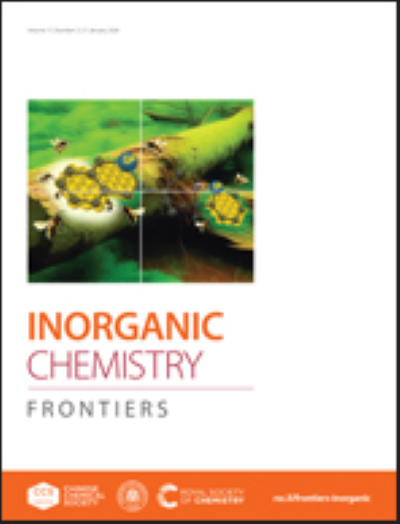In-situ construction of donor-acceptor structured g-C3N4 nanotubes incorporated with pyridine heterocyclic rings for efficient photocatalytic water splitting
IF 6.1
1区 化学
Q1 CHEMISTRY, INORGANIC & NUCLEAR
引用次数: 0
Abstract
polymeric carbon nitrides (PCN), as an emerging class of metal-free photocatalysts, have demonstrated significant potential in the field of solar energy conversion, particularly in the areas of water splitting. But the utilization of it is restricted by high carrier recombination rate and low charge transfer efficiency. In order to address these challenges, this work chooses pyridyl organic small molecules nicotinic acid and melamine to construct donor-acceptor (D-A) structured carbon nitride nanotubes. Pyridine heterocyclic rings are converged at the edge of the PCN structure via supramolecular self-assembly, facilitating the fabrication of donor-acceptor structured g-C3N4 nanotubes. Strong electronic ability of the pyridine heterocyclic rings establishes a preferential electronic transfer pathway within the D-A composite material, effectively mitigating carrier recombination within the plane. In addition, the unique hollow tubular structure of carbon nitride nanotubes enhances the visible light absorption ability, expands the surface area of the catalyst, and then increases the catalytically active sites, consequently enhancing photocatalytic performance. The photocatalytic activity of one-dimensional tubular carbon nitride doped with 100 mg nicotinic acid (designated as NA100-CN) is 2584.2 µmol g-1 h-1, which is 4.7 times that of the single PCN. This investigation elucidates the mechanism of charge transfer from D to A, describing the response mechanism of photocatalysis, with profound implications for advancing clean energy, environmental preservation, and sustainable development.原位构建加入吡啶杂环的供体-受体结构 g-C3N4 纳米管,用于高效光催化水分离
聚合碳氮化物(PCN)作为一类新兴的无金属光催化剂,在太阳能转换领域,尤其是在水分离领域展现出了巨大的潜力。但其利用受到高载流子重组率和低电荷转移效率的限制。为了解决这些难题,本研究选择吡啶基有机小分子烟酸和三聚氰胺来构建供体-受体(D-A)结构的氮化碳纳米管。吡啶杂环通过超分子自组装汇聚到 PCN 结构的边缘,促进了供体-受体结构 g-C3N4 纳米管的制备。吡啶杂环的强电子能力在 D-A 复合材料内部建立了优先电子转移途径,有效地缓解了平面内的载流子重组。此外,氮化碳纳米管独特的中空管状结构增强了对可见光的吸收能力,扩大了催化剂的表面积,进而增加了催化活性位点,从而提高了光催化性能。掺杂了 100 毫克烟酸的一维管状氮化碳(命名为 NA100-CN)的光催化活性为 2584.2 µmol g-1 h-1,是单一 PCN 的 4.7 倍。这项研究阐明了从 D 到 A 的电荷转移机制,描述了光催化的响应机制,对推进清洁能源、环境保护和可持续发展具有深远影响。
本文章由计算机程序翻译,如有差异,请以英文原文为准。
求助全文
约1分钟内获得全文
求助全文
来源期刊

Inorganic Chemistry Frontiers
CHEMISTRY, INORGANIC & NUCLEAR-
CiteScore
10.40
自引率
7.10%
发文量
587
审稿时长
1.2 months
期刊介绍:
The international, high quality journal for interdisciplinary research between inorganic chemistry and related subjects
 求助内容:
求助内容: 应助结果提醒方式:
应助结果提醒方式:


